Legal Analysis: Consumer Law, Negligence, and Statutory Guarantees
VerifiedAdded on 2023/06/04
|11
|2874
|58
Case Study
AI Summary
This case study examines two scenarios under Australian Consumer Law (ACL) and negligence principles. The first scenario involves Ann, who became ill after consuming contaminated salami, raising issues of statutory guarantees against Smallgoods Pty Ltd, the manufacturer, and the enforceability of Supermarkets Pty Ltd's liability limitation. The analysis considers sections 54 and 138 of the ACL, addressing acceptable quality and manufacturer liability. The second scenario involves Shanti, an employee of U-Bewt Shoes factory, who was attacked in the factory car park. The analysis applies the principles from Modbury Triangle v Anzil to determine the factory's liability for Shanti's injuries, focusing on the duty of care and foreseeability of harm. The study employs the IRAC method (Issue, Rule, Application, Conclusion) to systematically analyze the legal issues and provide reasoned conclusions, referencing relevant legal sources including cases and legislation. Desklib offers a platform for students to access this and other solved assignments and past papers.
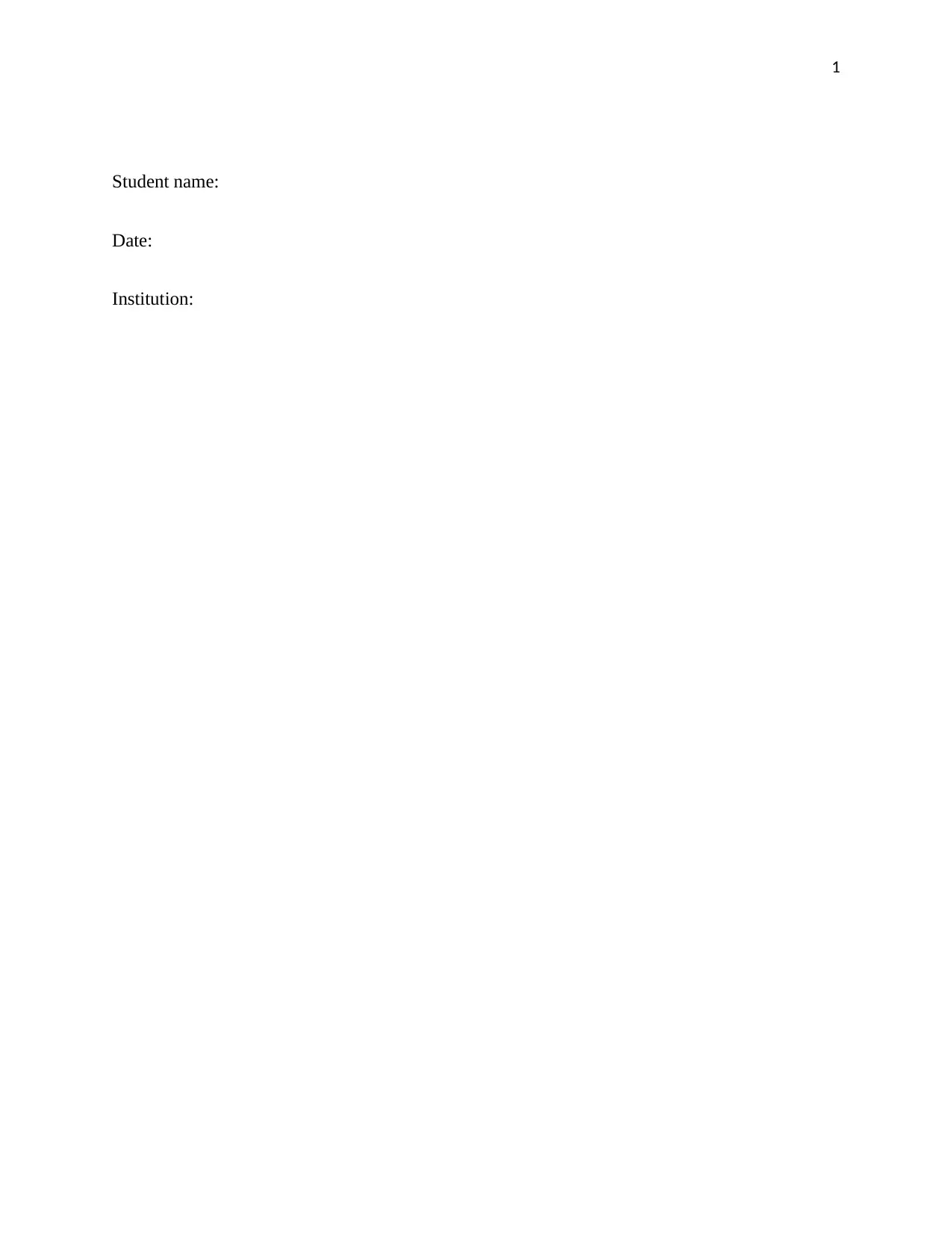
1
Student name:
Date:
Institution:
Student name:
Date:
Institution:
Paraphrase This Document
Need a fresh take? Get an instant paraphrase of this document with our AI Paraphraser
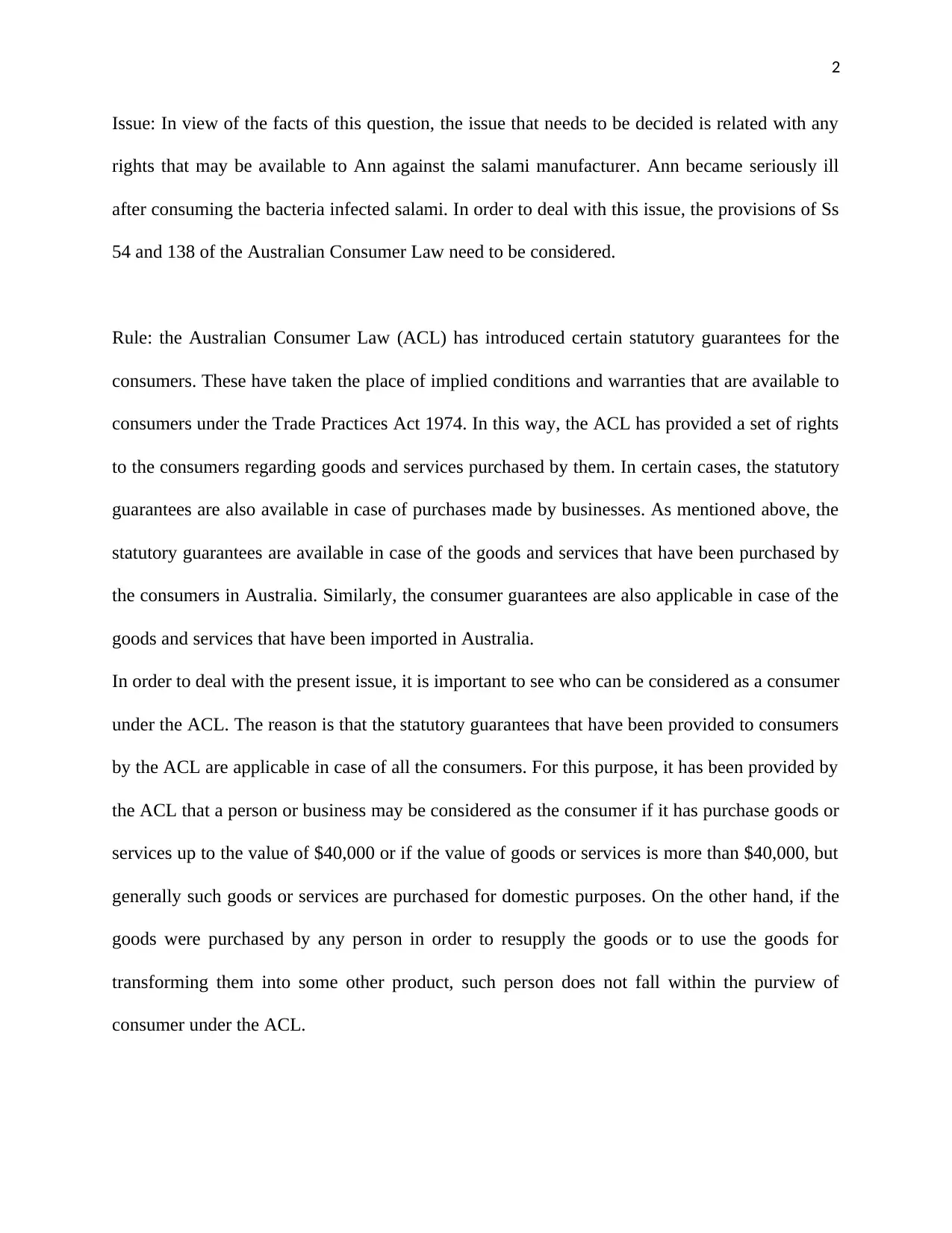
2
Issue: In view of the facts of this question, the issue that needs to be decided is related with any
rights that may be available to Ann against the salami manufacturer. Ann became seriously ill
after consuming the bacteria infected salami. In order to deal with this issue, the provisions of Ss
54 and 138 of the Australian Consumer Law need to be considered.
Rule: the Australian Consumer Law (ACL) has introduced certain statutory guarantees for the
consumers. These have taken the place of implied conditions and warranties that are available to
consumers under the Trade Practices Act 1974. In this way, the ACL has provided a set of rights
to the consumers regarding goods and services purchased by them. In certain cases, the statutory
guarantees are also available in case of purchases made by businesses. As mentioned above, the
statutory guarantees are available in case of the goods and services that have been purchased by
the consumers in Australia. Similarly, the consumer guarantees are also applicable in case of the
goods and services that have been imported in Australia.
In order to deal with the present issue, it is important to see who can be considered as a consumer
under the ACL. The reason is that the statutory guarantees that have been provided to consumers
by the ACL are applicable in case of all the consumers. For this purpose, it has been provided by
the ACL that a person or business may be considered as the consumer if it has purchase goods or
services up to the value of $40,000 or if the value of goods or services is more than $40,000, but
generally such goods or services are purchased for domestic purposes. On the other hand, if the
goods were purchased by any person in order to resupply the goods or to use the goods for
transforming them into some other product, such person does not fall within the purview of
consumer under the ACL.
Issue: In view of the facts of this question, the issue that needs to be decided is related with any
rights that may be available to Ann against the salami manufacturer. Ann became seriously ill
after consuming the bacteria infected salami. In order to deal with this issue, the provisions of Ss
54 and 138 of the Australian Consumer Law need to be considered.
Rule: the Australian Consumer Law (ACL) has introduced certain statutory guarantees for the
consumers. These have taken the place of implied conditions and warranties that are available to
consumers under the Trade Practices Act 1974. In this way, the ACL has provided a set of rights
to the consumers regarding goods and services purchased by them. In certain cases, the statutory
guarantees are also available in case of purchases made by businesses. As mentioned above, the
statutory guarantees are available in case of the goods and services that have been purchased by
the consumers in Australia. Similarly, the consumer guarantees are also applicable in case of the
goods and services that have been imported in Australia.
In order to deal with the present issue, it is important to see who can be considered as a consumer
under the ACL. The reason is that the statutory guarantees that have been provided to consumers
by the ACL are applicable in case of all the consumers. For this purpose, it has been provided by
the ACL that a person or business may be considered as the consumer if it has purchase goods or
services up to the value of $40,000 or if the value of goods or services is more than $40,000, but
generally such goods or services are purchased for domestic purposes. On the other hand, if the
goods were purchased by any person in order to resupply the goods or to use the goods for
transforming them into some other product, such person does not fall within the purview of
consumer under the ACL.
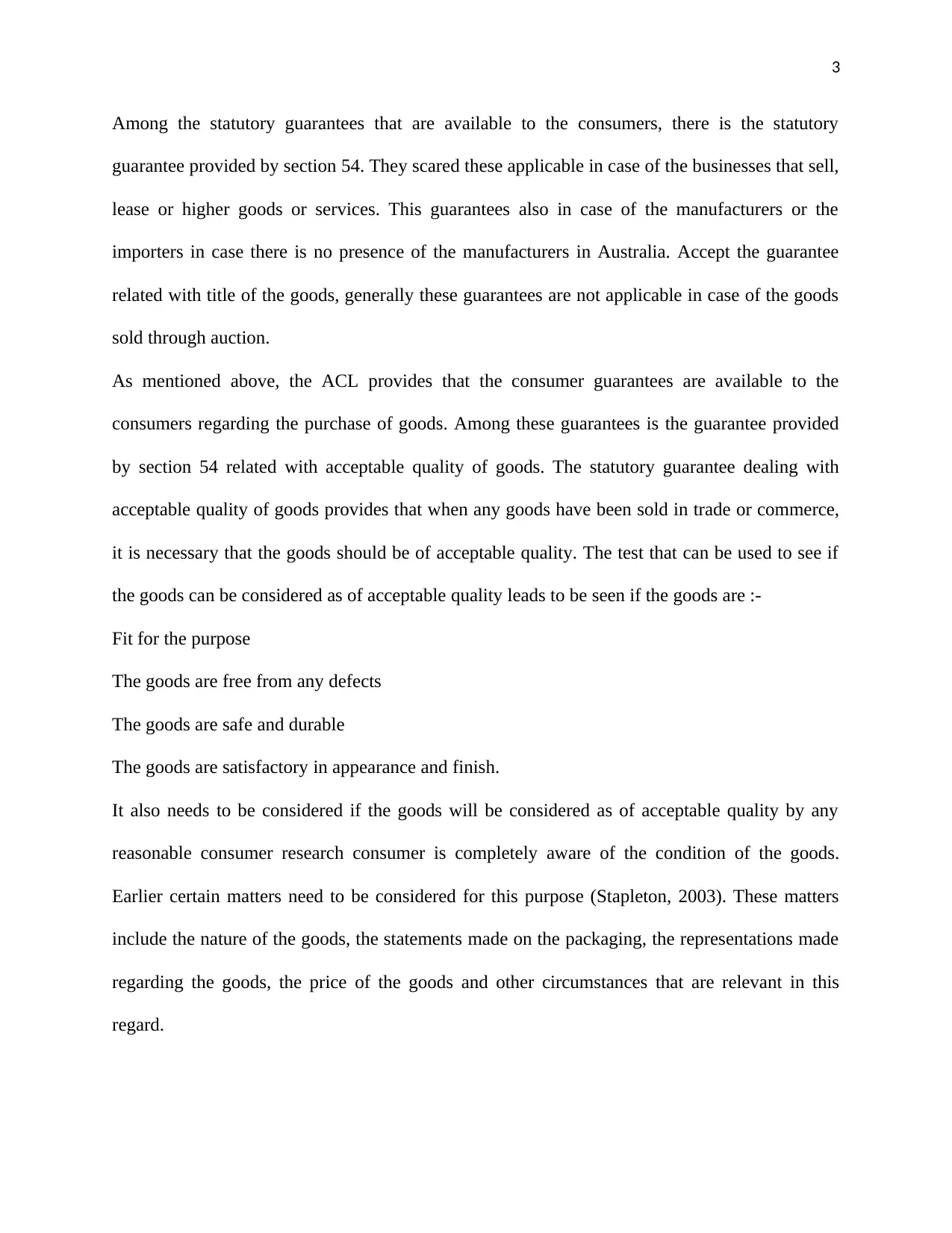
3
Among the statutory guarantees that are available to the consumers, there is the statutory
guarantee provided by section 54. They scared these applicable in case of the businesses that sell,
lease or higher goods or services. This guarantees also in case of the manufacturers or the
importers in case there is no presence of the manufacturers in Australia. Accept the guarantee
related with title of the goods, generally these guarantees are not applicable in case of the goods
sold through auction.
As mentioned above, the ACL provides that the consumer guarantees are available to the
consumers regarding the purchase of goods. Among these guarantees is the guarantee provided
by section 54 related with acceptable quality of goods. The statutory guarantee dealing with
acceptable quality of goods provides that when any goods have been sold in trade or commerce,
it is necessary that the goods should be of acceptable quality. The test that can be used to see if
the goods can be considered as of acceptable quality leads to be seen if the goods are :-
Fit for the purpose
The goods are free from any defects
The goods are safe and durable
The goods are satisfactory in appearance and finish.
It also needs to be considered if the goods will be considered as of acceptable quality by any
reasonable consumer research consumer is completely aware of the condition of the goods.
Earlier certain matters need to be considered for this purpose (Stapleton, 2003). These matters
include the nature of the goods, the statements made on the packaging, the representations made
regarding the goods, the price of the goods and other circumstances that are relevant in this
regard.
Among the statutory guarantees that are available to the consumers, there is the statutory
guarantee provided by section 54. They scared these applicable in case of the businesses that sell,
lease or higher goods or services. This guarantees also in case of the manufacturers or the
importers in case there is no presence of the manufacturers in Australia. Accept the guarantee
related with title of the goods, generally these guarantees are not applicable in case of the goods
sold through auction.
As mentioned above, the ACL provides that the consumer guarantees are available to the
consumers regarding the purchase of goods. Among these guarantees is the guarantee provided
by section 54 related with acceptable quality of goods. The statutory guarantee dealing with
acceptable quality of goods provides that when any goods have been sold in trade or commerce,
it is necessary that the goods should be of acceptable quality. The test that can be used to see if
the goods can be considered as of acceptable quality leads to be seen if the goods are :-
Fit for the purpose
The goods are free from any defects
The goods are safe and durable
The goods are satisfactory in appearance and finish.
It also needs to be considered if the goods will be considered as of acceptable quality by any
reasonable consumer research consumer is completely aware of the condition of the goods.
Earlier certain matters need to be considered for this purpose (Stapleton, 2003). These matters
include the nature of the goods, the statements made on the packaging, the representations made
regarding the goods, the price of the goods and other circumstances that are relevant in this
regard.
⊘ This is a preview!⊘
Do you want full access?
Subscribe today to unlock all pages.

Trusted by 1+ million students worldwide
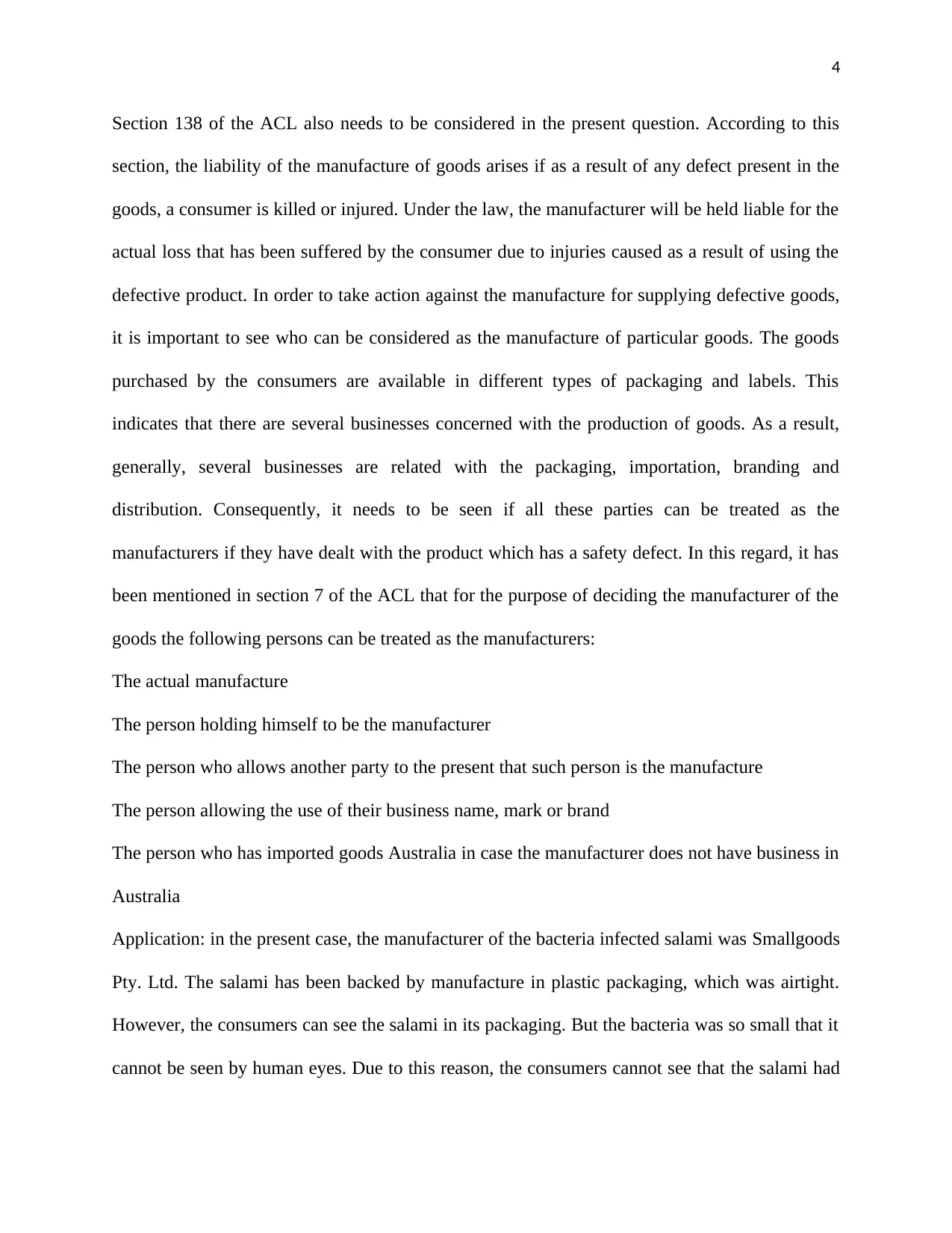
4
Section 138 of the ACL also needs to be considered in the present question. According to this
section, the liability of the manufacture of goods arises if as a result of any defect present in the
goods, a consumer is killed or injured. Under the law, the manufacturer will be held liable for the
actual loss that has been suffered by the consumer due to injuries caused as a result of using the
defective product. In order to take action against the manufacture for supplying defective goods,
it is important to see who can be considered as the manufacture of particular goods. The goods
purchased by the consumers are available in different types of packaging and labels. This
indicates that there are several businesses concerned with the production of goods. As a result,
generally, several businesses are related with the packaging, importation, branding and
distribution. Consequently, it needs to be seen if all these parties can be treated as the
manufacturers if they have dealt with the product which has a safety defect. In this regard, it has
been mentioned in section 7 of the ACL that for the purpose of deciding the manufacturer of the
goods the following persons can be treated as the manufacturers:
The actual manufacture
The person holding himself to be the manufacturer
The person who allows another party to the present that such person is the manufacture
The person allowing the use of their business name, mark or brand
The person who has imported goods Australia in case the manufacturer does not have business in
Australia
Application: in the present case, the manufacturer of the bacteria infected salami was Smallgoods
Pty. Ltd. The salami has been backed by manufacture in plastic packaging, which was airtight.
However, the consumers can see the salami in its packaging. But the bacteria was so small that it
cannot be seen by human eyes. Due to this reason, the consumers cannot see that the salami had
Section 138 of the ACL also needs to be considered in the present question. According to this
section, the liability of the manufacture of goods arises if as a result of any defect present in the
goods, a consumer is killed or injured. Under the law, the manufacturer will be held liable for the
actual loss that has been suffered by the consumer due to injuries caused as a result of using the
defective product. In order to take action against the manufacture for supplying defective goods,
it is important to see who can be considered as the manufacture of particular goods. The goods
purchased by the consumers are available in different types of packaging and labels. This
indicates that there are several businesses concerned with the production of goods. As a result,
generally, several businesses are related with the packaging, importation, branding and
distribution. Consequently, it needs to be seen if all these parties can be treated as the
manufacturers if they have dealt with the product which has a safety defect. In this regard, it has
been mentioned in section 7 of the ACL that for the purpose of deciding the manufacturer of the
goods the following persons can be treated as the manufacturers:
The actual manufacture
The person holding himself to be the manufacturer
The person who allows another party to the present that such person is the manufacture
The person allowing the use of their business name, mark or brand
The person who has imported goods Australia in case the manufacturer does not have business in
Australia
Application: in the present case, the manufacturer of the bacteria infected salami was Smallgoods
Pty. Ltd. The salami has been backed by manufacture in plastic packaging, which was airtight.
However, the consumers can see the salami in its packaging. But the bacteria was so small that it
cannot be seen by human eyes. Due to this reason, the consumers cannot see that the salami had
Paraphrase This Document
Need a fresh take? Get an instant paraphrase of this document with our AI Paraphraser
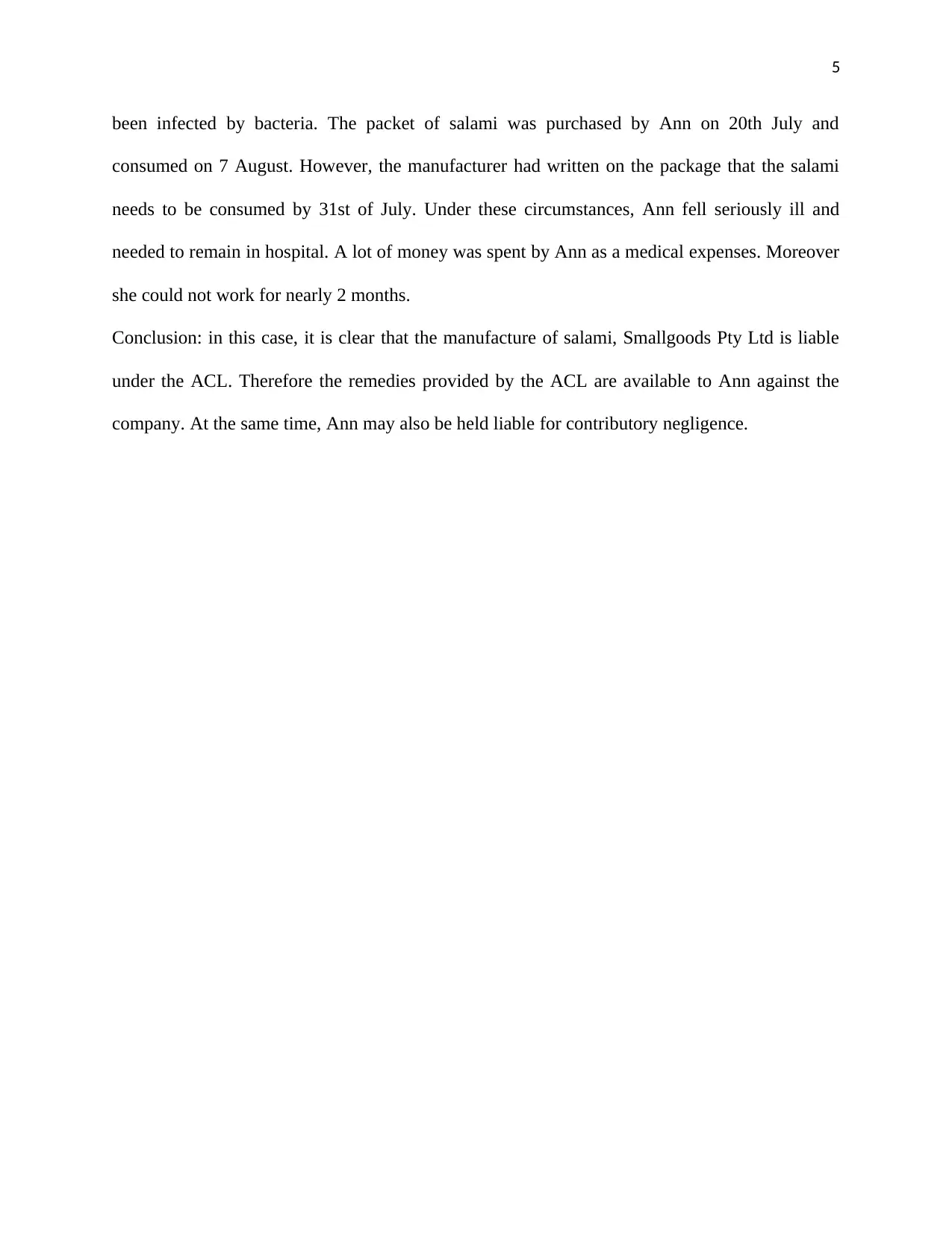
5
been infected by bacteria. The packet of salami was purchased by Ann on 20th July and
consumed on 7 August. However, the manufacturer had written on the package that the salami
needs to be consumed by 31st of July. Under these circumstances, Ann fell seriously ill and
needed to remain in hospital. A lot of money was spent by Ann as a medical expenses. Moreover
she could not work for nearly 2 months.
Conclusion: in this case, it is clear that the manufacture of salami, Smallgoods Pty Ltd is liable
under the ACL. Therefore the remedies provided by the ACL are available to Ann against the
company. At the same time, Ann may also be held liable for contributory negligence.
been infected by bacteria. The packet of salami was purchased by Ann on 20th July and
consumed on 7 August. However, the manufacturer had written on the package that the salami
needs to be consumed by 31st of July. Under these circumstances, Ann fell seriously ill and
needed to remain in hospital. A lot of money was spent by Ann as a medical expenses. Moreover
she could not work for nearly 2 months.
Conclusion: in this case, it is clear that the manufacture of salami, Smallgoods Pty Ltd is liable
under the ACL. Therefore the remedies provided by the ACL are available to Ann against the
company. At the same time, Ann may also be held liable for contributory negligence.
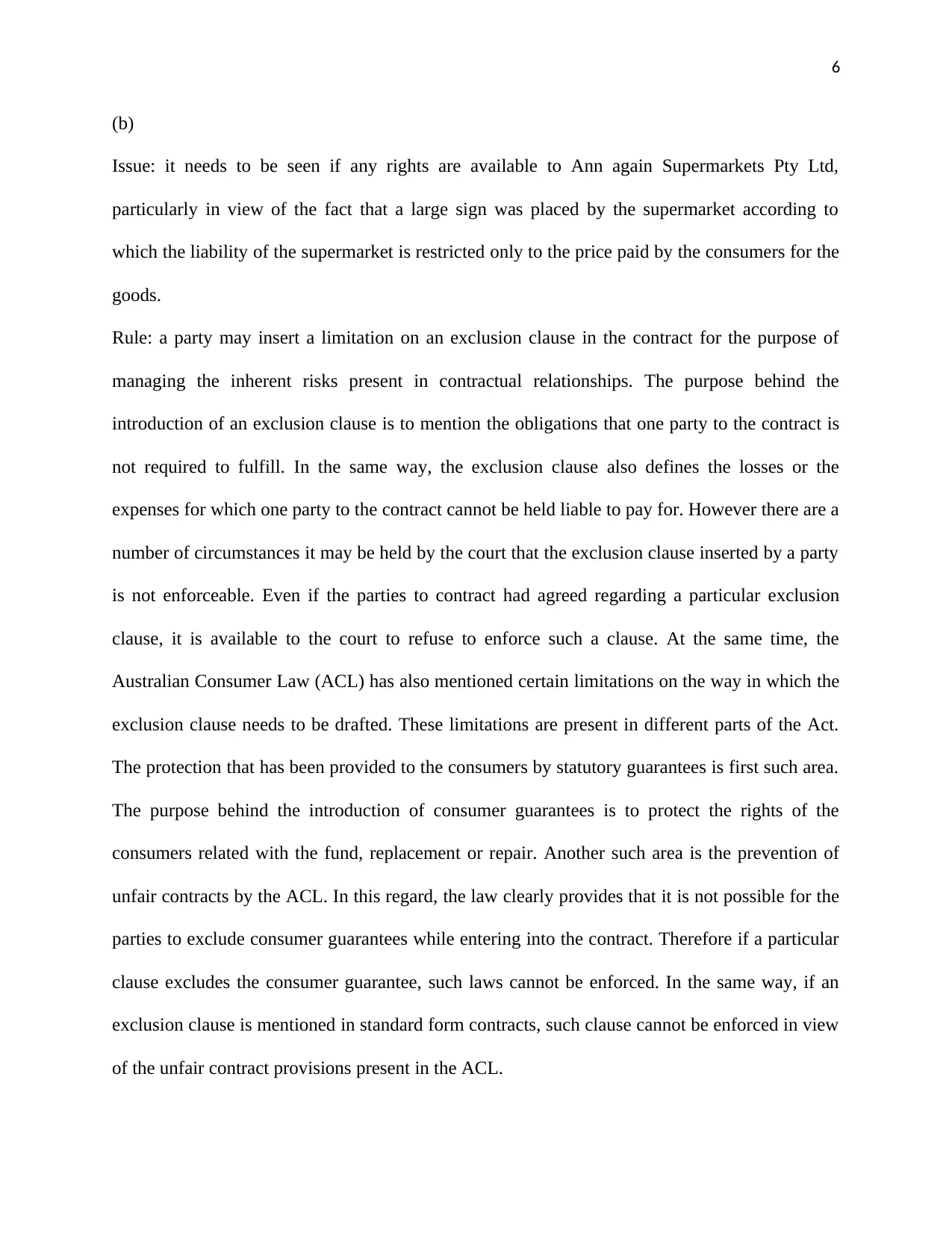
6
(b)
Issue: it needs to be seen if any rights are available to Ann again Supermarkets Pty Ltd,
particularly in view of the fact that a large sign was placed by the supermarket according to
which the liability of the supermarket is restricted only to the price paid by the consumers for the
goods.
Rule: a party may insert a limitation on an exclusion clause in the contract for the purpose of
managing the inherent risks present in contractual relationships. The purpose behind the
introduction of an exclusion clause is to mention the obligations that one party to the contract is
not required to fulfill. In the same way, the exclusion clause also defines the losses or the
expenses for which one party to the contract cannot be held liable to pay for. However there are a
number of circumstances it may be held by the court that the exclusion clause inserted by a party
is not enforceable. Even if the parties to contract had agreed regarding a particular exclusion
clause, it is available to the court to refuse to enforce such a clause. At the same time, the
Australian Consumer Law (ACL) has also mentioned certain limitations on the way in which the
exclusion clause needs to be drafted. These limitations are present in different parts of the Act.
The protection that has been provided to the consumers by statutory guarantees is first such area.
The purpose behind the introduction of consumer guarantees is to protect the rights of the
consumers related with the fund, replacement or repair. Another such area is the prevention of
unfair contracts by the ACL. In this regard, the law clearly provides that it is not possible for the
parties to exclude consumer guarantees while entering into the contract. Therefore if a particular
clause excludes the consumer guarantee, such laws cannot be enforced. In the same way, if an
exclusion clause is mentioned in standard form contracts, such clause cannot be enforced in view
of the unfair contract provisions present in the ACL.
(b)
Issue: it needs to be seen if any rights are available to Ann again Supermarkets Pty Ltd,
particularly in view of the fact that a large sign was placed by the supermarket according to
which the liability of the supermarket is restricted only to the price paid by the consumers for the
goods.
Rule: a party may insert a limitation on an exclusion clause in the contract for the purpose of
managing the inherent risks present in contractual relationships. The purpose behind the
introduction of an exclusion clause is to mention the obligations that one party to the contract is
not required to fulfill. In the same way, the exclusion clause also defines the losses or the
expenses for which one party to the contract cannot be held liable to pay for. However there are a
number of circumstances it may be held by the court that the exclusion clause inserted by a party
is not enforceable. Even if the parties to contract had agreed regarding a particular exclusion
clause, it is available to the court to refuse to enforce such a clause. At the same time, the
Australian Consumer Law (ACL) has also mentioned certain limitations on the way in which the
exclusion clause needs to be drafted. These limitations are present in different parts of the Act.
The protection that has been provided to the consumers by statutory guarantees is first such area.
The purpose behind the introduction of consumer guarantees is to protect the rights of the
consumers related with the fund, replacement or repair. Another such area is the prevention of
unfair contracts by the ACL. In this regard, the law clearly provides that it is not possible for the
parties to exclude consumer guarantees while entering into the contract. Therefore if a particular
clause excludes the consumer guarantee, such laws cannot be enforced. In the same way, if an
exclusion clause is mentioned in standard form contracts, such clause cannot be enforced in view
of the unfair contract provisions present in the ACL.
⊘ This is a preview!⊘
Do you want full access?
Subscribe today to unlock all pages.

Trusted by 1+ million students worldwide
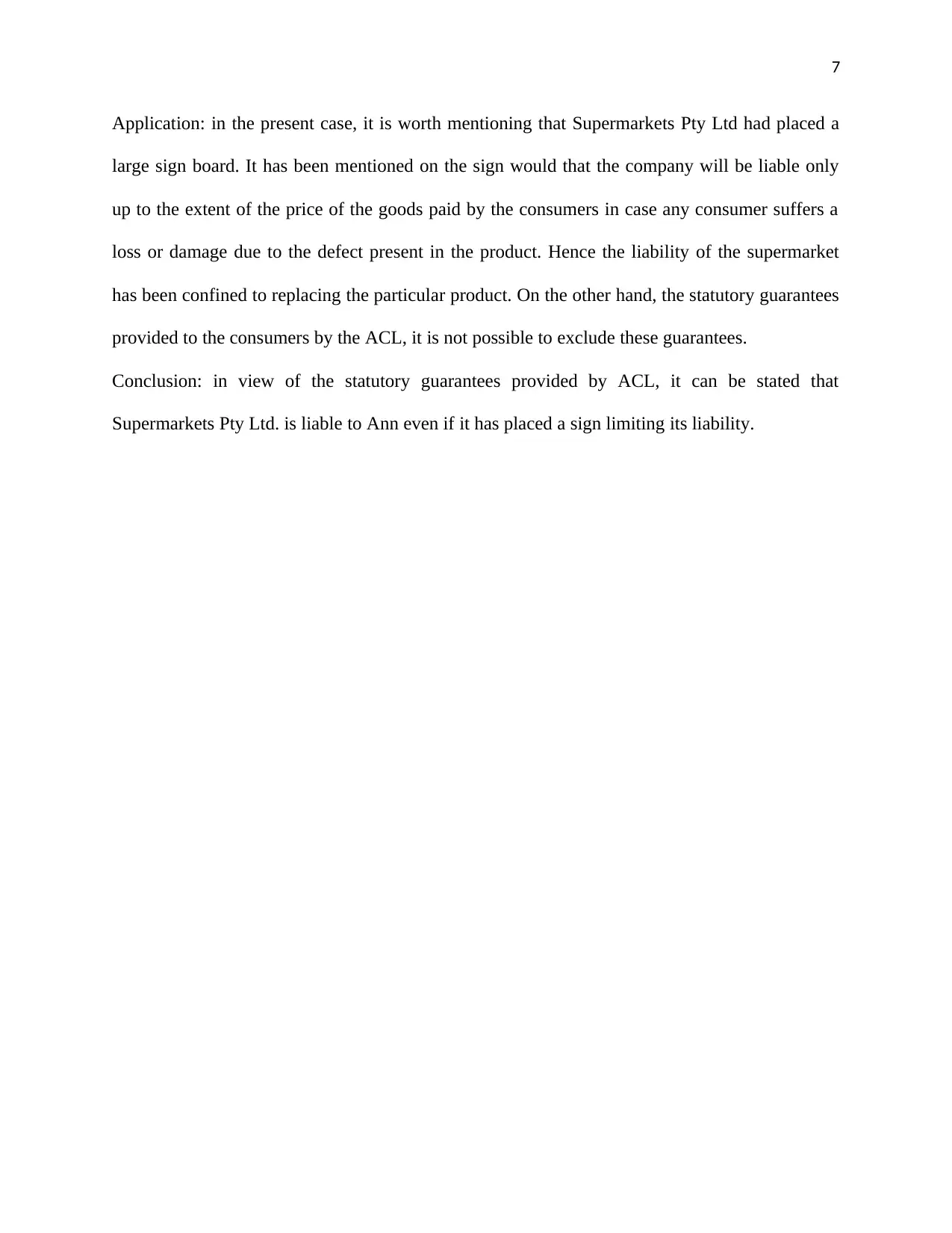
7
Application: in the present case, it is worth mentioning that Supermarkets Pty Ltd had placed a
large sign board. It has been mentioned on the sign would that the company will be liable only
up to the extent of the price of the goods paid by the consumers in case any consumer suffers a
loss or damage due to the defect present in the product. Hence the liability of the supermarket
has been confined to replacing the particular product. On the other hand, the statutory guarantees
provided to the consumers by the ACL, it is not possible to exclude these guarantees.
Conclusion: in view of the statutory guarantees provided by ACL, it can be stated that
Supermarkets Pty Ltd. is liable to Ann even if it has placed a sign limiting its liability.
Application: in the present case, it is worth mentioning that Supermarkets Pty Ltd had placed a
large sign board. It has been mentioned on the sign would that the company will be liable only
up to the extent of the price of the goods paid by the consumers in case any consumer suffers a
loss or damage due to the defect present in the product. Hence the liability of the supermarket
has been confined to replacing the particular product. On the other hand, the statutory guarantees
provided to the consumers by the ACL, it is not possible to exclude these guarantees.
Conclusion: in view of the statutory guarantees provided by ACL, it can be stated that
Supermarkets Pty Ltd. is liable to Ann even if it has placed a sign limiting its liability.
Paraphrase This Document
Need a fresh take? Get an instant paraphrase of this document with our AI Paraphraser
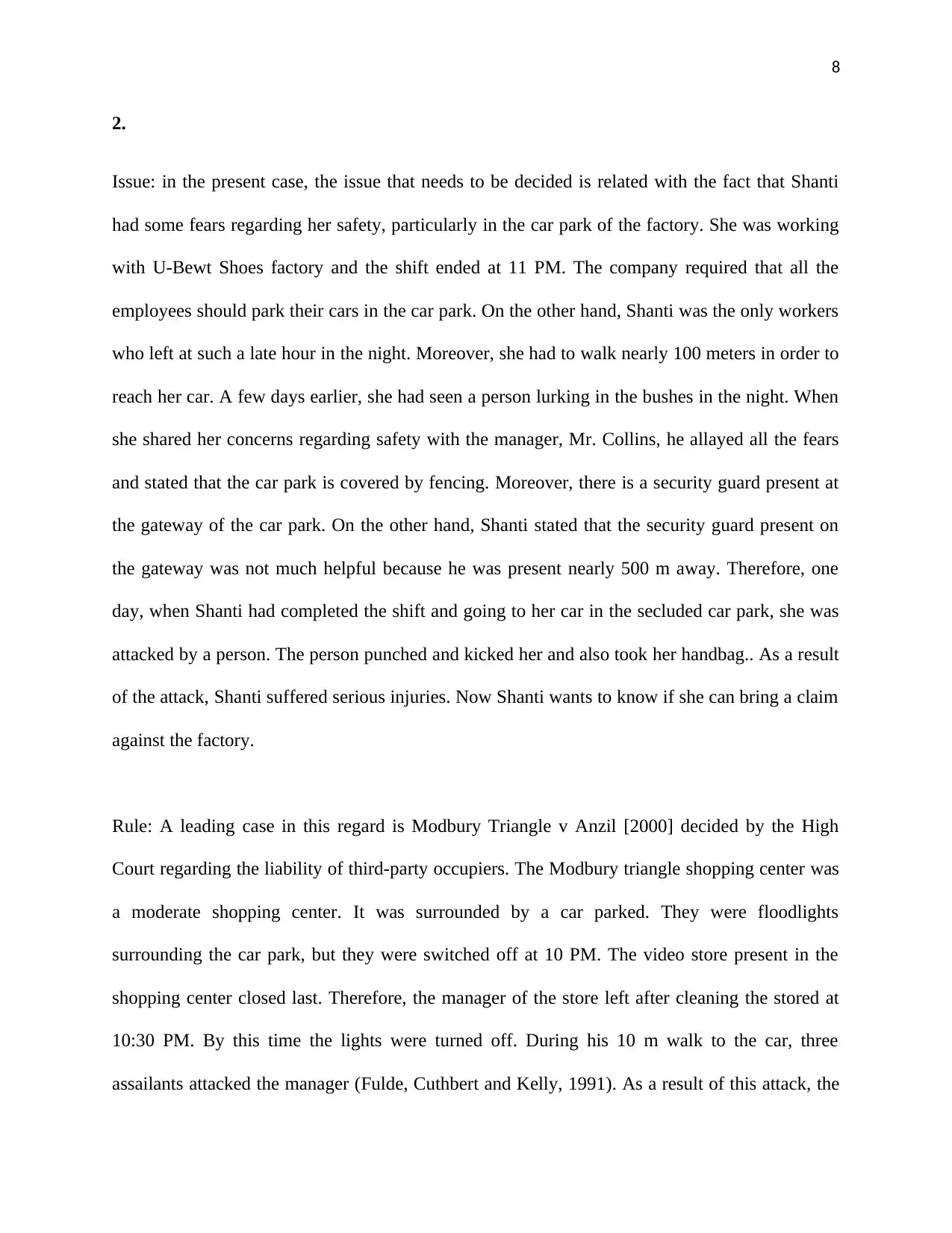
8
2.
Issue: in the present case, the issue that needs to be decided is related with the fact that Shanti
had some fears regarding her safety, particularly in the car park of the factory. She was working
with U-Bewt Shoes factory and the shift ended at 11 PM. The company required that all the
employees should park their cars in the car park. On the other hand, Shanti was the only workers
who left at such a late hour in the night. Moreover, she had to walk nearly 100 meters in order to
reach her car. A few days earlier, she had seen a person lurking in the bushes in the night. When
she shared her concerns regarding safety with the manager, Mr. Collins, he allayed all the fears
and stated that the car park is covered by fencing. Moreover, there is a security guard present at
the gateway of the car park. On the other hand, Shanti stated that the security guard present on
the gateway was not much helpful because he was present nearly 500 m away. Therefore, one
day, when Shanti had completed the shift and going to her car in the secluded car park, she was
attacked by a person. The person punched and kicked her and also took her handbag.. As a result
of the attack, Shanti suffered serious injuries. Now Shanti wants to know if she can bring a claim
against the factory.
Rule: A leading case in this regard is Modbury Triangle v Anzil [2000] decided by the High
Court regarding the liability of third-party occupiers. The Modbury triangle shopping center was
a moderate shopping center. It was surrounded by a car parked. They were floodlights
surrounding the car park, but they were switched off at 10 PM. The video store present in the
shopping center closed last. Therefore, the manager of the store left after cleaning the stored at
10:30 PM. By this time the lights were turned off. During his 10 m walk to the car, three
assailants attacked the manager (Fulde, Cuthbert and Kelly, 1991). As a result of this attack, the
2.
Issue: in the present case, the issue that needs to be decided is related with the fact that Shanti
had some fears regarding her safety, particularly in the car park of the factory. She was working
with U-Bewt Shoes factory and the shift ended at 11 PM. The company required that all the
employees should park their cars in the car park. On the other hand, Shanti was the only workers
who left at such a late hour in the night. Moreover, she had to walk nearly 100 meters in order to
reach her car. A few days earlier, she had seen a person lurking in the bushes in the night. When
she shared her concerns regarding safety with the manager, Mr. Collins, he allayed all the fears
and stated that the car park is covered by fencing. Moreover, there is a security guard present at
the gateway of the car park. On the other hand, Shanti stated that the security guard present on
the gateway was not much helpful because he was present nearly 500 m away. Therefore, one
day, when Shanti had completed the shift and going to her car in the secluded car park, she was
attacked by a person. The person punched and kicked her and also took her handbag.. As a result
of the attack, Shanti suffered serious injuries. Now Shanti wants to know if she can bring a claim
against the factory.
Rule: A leading case in this regard is Modbury Triangle v Anzil [2000] decided by the High
Court regarding the liability of third-party occupiers. The Modbury triangle shopping center was
a moderate shopping center. It was surrounded by a car parked. They were floodlights
surrounding the car park, but they were switched off at 10 PM. The video store present in the
shopping center closed last. Therefore, the manager of the store left after cleaning the stored at
10:30 PM. By this time the lights were turned off. During his 10 m walk to the car, three
assailants attacked the manager (Fulde, Cuthbert and Kelly, 1991). As a result of this attack, the
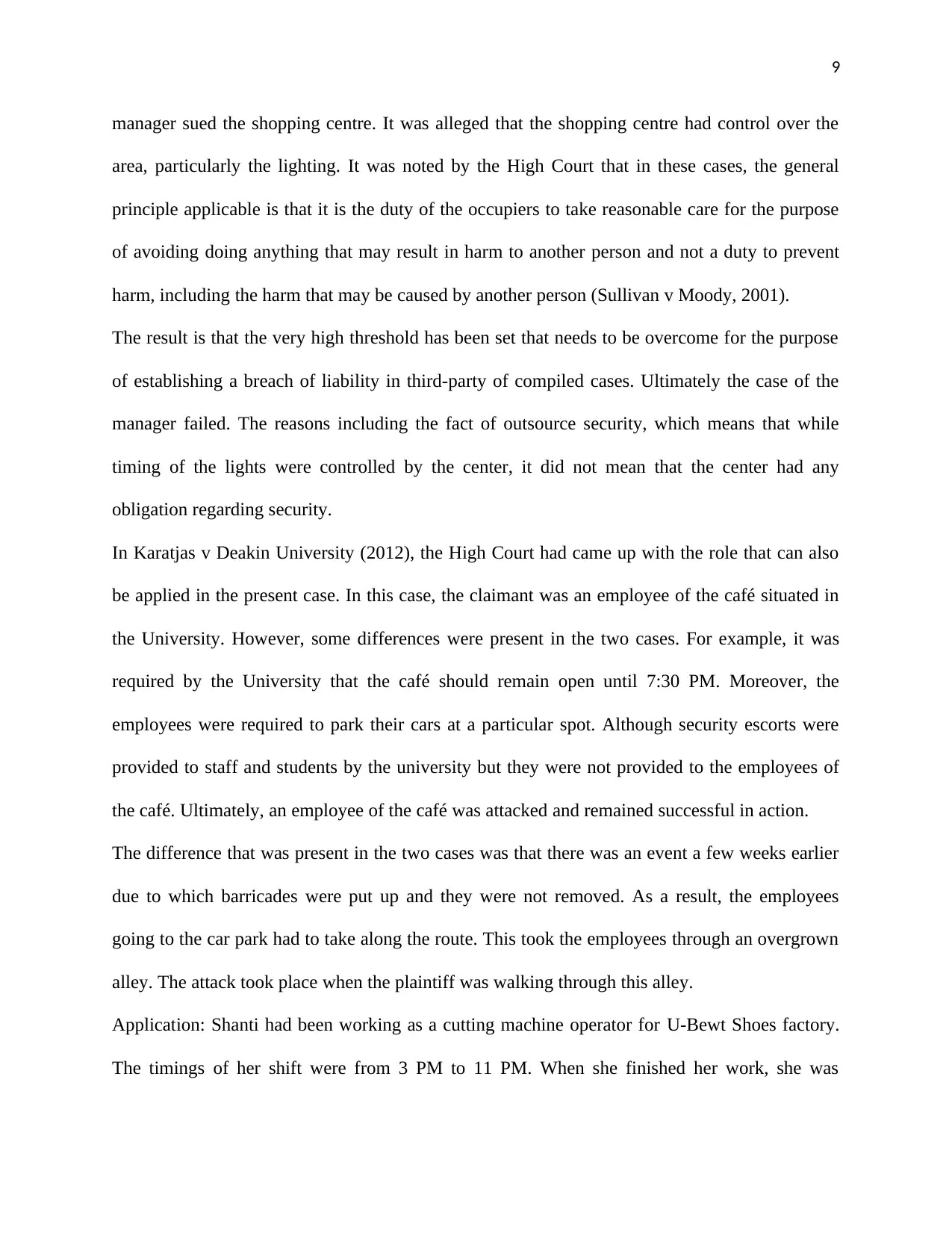
9
manager sued the shopping centre. It was alleged that the shopping centre had control over the
area, particularly the lighting. It was noted by the High Court that in these cases, the general
principle applicable is that it is the duty of the occupiers to take reasonable care for the purpose
of avoiding doing anything that may result in harm to another person and not a duty to prevent
harm, including the harm that may be caused by another person (Sullivan v Moody, 2001).
The result is that the very high threshold has been set that needs to be overcome for the purpose
of establishing a breach of liability in third-party of compiled cases. Ultimately the case of the
manager failed. The reasons including the fact of outsource security, which means that while
timing of the lights were controlled by the center, it did not mean that the center had any
obligation regarding security.
In Karatjas v Deakin University (2012), the High Court had came up with the role that can also
be applied in the present case. In this case, the claimant was an employee of the café situated in
the University. However, some differences were present in the two cases. For example, it was
required by the University that the café should remain open until 7:30 PM. Moreover, the
employees were required to park their cars at a particular spot. Although security escorts were
provided to staff and students by the university but they were not provided to the employees of
the café. Ultimately, an employee of the café was attacked and remained successful in action.
The difference that was present in the two cases was that there was an event a few weeks earlier
due to which barricades were put up and they were not removed. As a result, the employees
going to the car park had to take along the route. This took the employees through an overgrown
alley. The attack took place when the plaintiff was walking through this alley.
Application: Shanti had been working as a cutting machine operator for U-Bewt Shoes factory.
The timings of her shift were from 3 PM to 11 PM. When she finished her work, she was
manager sued the shopping centre. It was alleged that the shopping centre had control over the
area, particularly the lighting. It was noted by the High Court that in these cases, the general
principle applicable is that it is the duty of the occupiers to take reasonable care for the purpose
of avoiding doing anything that may result in harm to another person and not a duty to prevent
harm, including the harm that may be caused by another person (Sullivan v Moody, 2001).
The result is that the very high threshold has been set that needs to be overcome for the purpose
of establishing a breach of liability in third-party of compiled cases. Ultimately the case of the
manager failed. The reasons including the fact of outsource security, which means that while
timing of the lights were controlled by the center, it did not mean that the center had any
obligation regarding security.
In Karatjas v Deakin University (2012), the High Court had came up with the role that can also
be applied in the present case. In this case, the claimant was an employee of the café situated in
the University. However, some differences were present in the two cases. For example, it was
required by the University that the café should remain open until 7:30 PM. Moreover, the
employees were required to park their cars at a particular spot. Although security escorts were
provided to staff and students by the university but they were not provided to the employees of
the café. Ultimately, an employee of the café was attacked and remained successful in action.
The difference that was present in the two cases was that there was an event a few weeks earlier
due to which barricades were put up and they were not removed. As a result, the employees
going to the car park had to take along the route. This took the employees through an overgrown
alley. The attack took place when the plaintiff was walking through this alley.
Application: Shanti had been working as a cutting machine operator for U-Bewt Shoes factory.
The timings of her shift were from 3 PM to 11 PM. When she finished her work, she was
⊘ This is a preview!⊘
Do you want full access?
Subscribe today to unlock all pages.

Trusted by 1+ million students worldwide
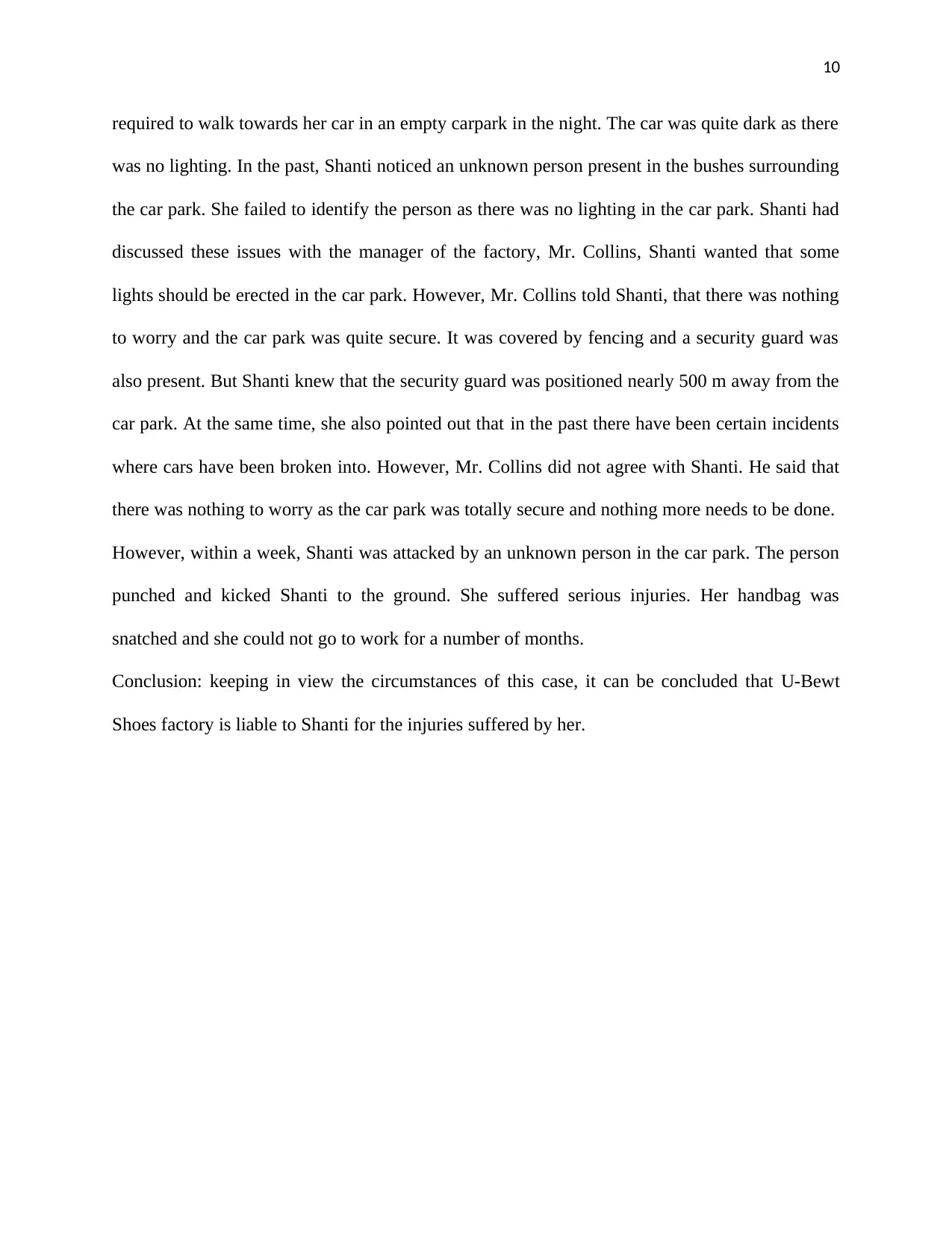
10
required to walk towards her car in an empty carpark in the night. The car was quite dark as there
was no lighting. In the past, Shanti noticed an unknown person present in the bushes surrounding
the car park. She failed to identify the person as there was no lighting in the car park. Shanti had
discussed these issues with the manager of the factory, Mr. Collins, Shanti wanted that some
lights should be erected in the car park. However, Mr. Collins told Shanti, that there was nothing
to worry and the car park was quite secure. It was covered by fencing and a security guard was
also present. But Shanti knew that the security guard was positioned nearly 500 m away from the
car park. At the same time, she also pointed out that in the past there have been certain incidents
where cars have been broken into. However, Mr. Collins did not agree with Shanti. He said that
there was nothing to worry as the car park was totally secure and nothing more needs to be done.
However, within a week, Shanti was attacked by an unknown person in the car park. The person
punched and kicked Shanti to the ground. She suffered serious injuries. Her handbag was
snatched and she could not go to work for a number of months.
Conclusion: keeping in view the circumstances of this case, it can be concluded that U-Bewt
Shoes factory is liable to Shanti for the injuries suffered by her.
required to walk towards her car in an empty carpark in the night. The car was quite dark as there
was no lighting. In the past, Shanti noticed an unknown person present in the bushes surrounding
the car park. She failed to identify the person as there was no lighting in the car park. Shanti had
discussed these issues with the manager of the factory, Mr. Collins, Shanti wanted that some
lights should be erected in the car park. However, Mr. Collins told Shanti, that there was nothing
to worry and the car park was quite secure. It was covered by fencing and a security guard was
also present. But Shanti knew that the security guard was positioned nearly 500 m away from the
car park. At the same time, she also pointed out that in the past there have been certain incidents
where cars have been broken into. However, Mr. Collins did not agree with Shanti. He said that
there was nothing to worry as the car park was totally secure and nothing more needs to be done.
However, within a week, Shanti was attacked by an unknown person in the car park. The person
punched and kicked Shanti to the ground. She suffered serious injuries. Her handbag was
snatched and she could not go to work for a number of months.
Conclusion: keeping in view the circumstances of this case, it can be concluded that U-Bewt
Shoes factory is liable to Shanti for the injuries suffered by her.
Paraphrase This Document
Need a fresh take? Get an instant paraphrase of this document with our AI Paraphraser
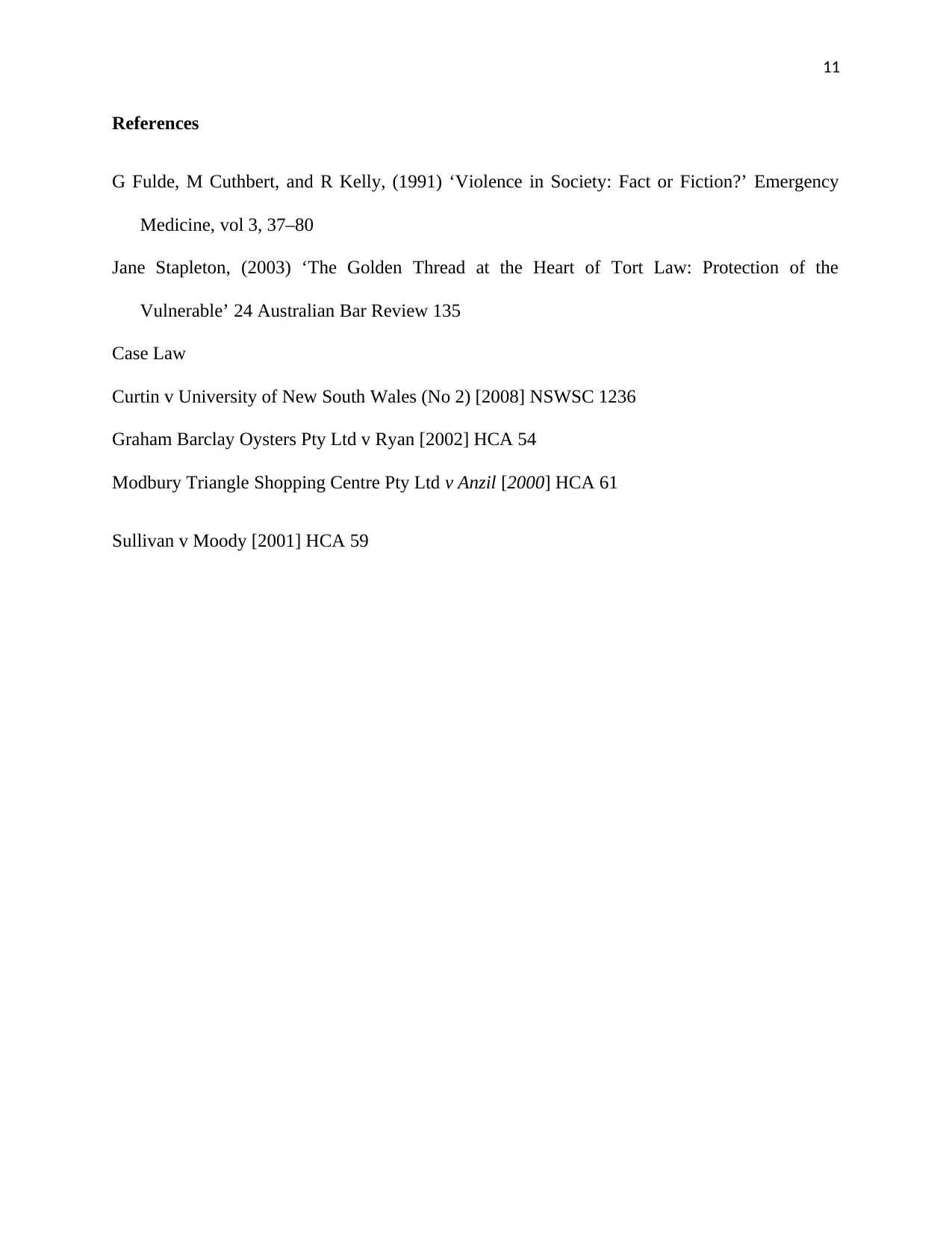
11
References
G Fulde, M Cuthbert, and R Kelly, (1991) ‘Violence in Society: Fact or Fiction?’ Emergency
Medicine, vol 3, 37–80
Jane Stapleton, (2003) ‘The Golden Thread at the Heart of Tort Law: Protection of the
Vulnerable’ 24 Australian Bar Review 135
Case Law
Curtin v University of New South Wales (No 2) [2008] NSWSC 1236
Graham Barclay Oysters Pty Ltd v Ryan [2002] HCA 54
Modbury Triangle Shopping Centre Pty Ltd v Anzil [2000] HCA 61
Sullivan v Moody [2001] HCA 59
References
G Fulde, M Cuthbert, and R Kelly, (1991) ‘Violence in Society: Fact or Fiction?’ Emergency
Medicine, vol 3, 37–80
Jane Stapleton, (2003) ‘The Golden Thread at the Heart of Tort Law: Protection of the
Vulnerable’ 24 Australian Bar Review 135
Case Law
Curtin v University of New South Wales (No 2) [2008] NSWSC 1236
Graham Barclay Oysters Pty Ltd v Ryan [2002] HCA 54
Modbury Triangle Shopping Centre Pty Ltd v Anzil [2000] HCA 61
Sullivan v Moody [2001] HCA 59
1 out of 11
Related Documents
Your All-in-One AI-Powered Toolkit for Academic Success.
+13062052269
info@desklib.com
Available 24*7 on WhatsApp / Email
![[object Object]](/_next/static/media/star-bottom.7253800d.svg)
Unlock your academic potential
Copyright © 2020–2025 A2Z Services. All Rights Reserved. Developed and managed by ZUCOL.





